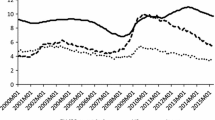Abstract
This study analyses asymmetries in the dynamic relationship between unemployment and the business cycle in the UK and the US. Unemployment rates present clear unconditional asymmetry in both countries. Markov switching regime models with two regimes also display clear asymmetries and show that, in the US, the effect of cyclical contractions on unemployment is much stronger than that of expansions, while in the UK it is observed that male unemployment is much more sensitive to cyclical variations than female unemployment.



Similar content being viewed by others
Notes
It is interesting to remark that the variations in the unemployment rates also depend on cyclical variations that will take place in the following quarter. This implies that the labour market anticipates imminent cyclical changes.
As is typical, we have chosen to specify a binary state variable, although we could represent a more flexible framework by allowing, for instance, for an additional intermediate state between pure expansion and pure contraction.
References
Acemoglu D, Scott A (1994) Asymmetries in the cyclical behavior of UK labor markets. Econ J 104:1303–1323
Andrews DW, Ploberger W (1994) Optimal tests when a nuisance parameter is present only under the alternative. Econometrica 62:1383–1414
Azmat G, Güell M, Manning A (2006) Gender gaps in unemployment rates in OECD countries. J Labor Econ 24:1–37
Becker R, Hurn S (2009) Testing for nonlinearity in mean in the presence of heteroskedasticity. Econ Anal Policy 39:311–326
Bentolila S, Bertola G (1990) Firing costs and labour demand: how bad is eurosclerosis? Rev Econ Stud 57:381–402
Campbell JR, Fisher JDM (2000) Aggregate employment fluctuations with macroeconomic asymmetries. Am Econ Rev 90:1323–1345
Carrasco M, Hu L, Ploberger W (2005) Optimal test for Markov switching. Mimeo, Economics Department, University of Rochester (Forthcoming in Econom.)
Cevik EI, Dibooglu S, Barisik S (2013) Asymmetry in the unemployment–output relationship over the business cycle: evidence from transition economies. Comp Econ Stud 55:557–581
Courtney HG (1991) The Beveridge curve and Okun’s law: a re-examination of fundamental relationships in the United States. PhD thesis, MIT
Crespo Cuaresma J (2003) Okun’s law revisited. Oxford Bull Econ Stat 65:439–451
Davies RB (1987) Hypothesis testing when a nuisance parameter is present only under the alternative. Biometrika 74:33–43
DeLong JB, Summers LH (1986) Are business cycles symmetrical? In: Gordon RJ (ed) The American business cycle. Continuity and change. The University of Chicago Press, Chicago, pp 166–179
Ewing BT, Levernier W, Malik F (2002) The differential effects of output shocks on unemployment rates by race and gender. South Econ J 68:584–599
Ewing BT, Levernier W, Malik F (2005) Modeling unemployment rates by race and gender: a nonlinear time series approach. East Econ J 31:333–347
Goldfeld SM, Quandt RE (1973) A Markov model for switching regressions. J Econ 1:3–16
Hamilton JD (1989) A new approach to the economic analysis of non-stationary time series and the business cycle. Econometrica 57:357–384
Hamilton JD (2005) What’s real about the business cycle? Fed Reserve Bank St Louis Rev 2005:425–452
Harris R, Silverstone B (2001) Testing for asymmetry in Okun’s law: a cross-country comparison. Econ Bull 5:1–13
Hodrick RJ, Prescott EC (1980) Postwar U.S. business cycles: an empirical investigation. Carnegie-Mellon University, Discussion Papers 451, Pittsburgh
Hodrick RJ, Prescott EC (1997) Postwar U.S. business cycles: an empirical investigation. J Money Credit Bank 29:1–16
Holmes MJ, Silverstone B (2006) Okun’s law, asymmetries and jobless recoveries in the United States: a Markov-switching approach. Econ Lett 92:293–299
Hotchkiss JL, Robertson JC (2012) Asymmetric labour force participation decisions. Appl Econ 44:2065–2073
Huang H, Chang Y (2005) Investigating Okun’s law by the structural break with threshold approach: evidence from Canada. Manch School 73:599–611
Huang H, Lin S (2006) A flexible nonlinear inference to Okun’s relationship. Appl Econ Lett 13:325–331
Hussey R (1992) Nonparametric evidence on asymmetry in business cycles using aggregate employment time series. J Econ 51:217–231
Keynes JM (1936) The general theory of employment, interest and money. Macmillan, London
Koop G, Potter SM (1999) Dynamic asymmetries in U.S. unemployment. J Bus Econ Stat 17:298–312
Mayes D, Virén M (2002) Asymmetry and the problem of aggregation in the euro area. Empirica 29:47–73
McKay A, Reis R (2008) The brevity and violence of contractions and expansions. J Monetary Econ 55:738–751
Mitchell WC (1927) Business cycles: the problem and its setting. National Bureau of Economic Research, New York
Mittnik S, Niu Z (1994) Asymmetries in business cycles: econometric techniques and empirical evidence. In: Semmler W (ed) Business cycles: theory and empirical methods. Kluwer Academic Publishers, Boston, pp 331–350
Neftçi SN (1984) Are economic times series asymmetric over the business cycle? J Polit Econ 92:307–328
Peiró A, Belaire-Franch J, Gonzalo MT (2012) Unemployment, cycle and gender. J Macroecon 34: 1167–1175
Pissarides CA (2003) Unemployment in Britain: a European success story. CEP Discussion Papers dp0600, Centre for Economic Performance, LSE
Plosser CI, Schwert GW (1977) Estimation of a non-invertible moving average process. J Econ 6:199–224
Queneau H, Sen A (2008) Evidence on the dynamics of unemployment by gender. Appl Econ 40:2099–2108
Racine JS, Maasoumi E (2007) A versatile and robust metric entropy test of time-reversibility, and other hypotheses. J Econ 138:547–567
Silvapulle P, Moosa IA, Silvapulle MJ (2004) Asymmetry in Okun’s law. Can J Econ 37:353–374
Teräsvirta T, Lin CF, Granger CWJ (1993) Power of the neural network linearity test. J Time Ser Anal 14:209–220
Virén M (2001) The Okun curve is non-linear. Econ Lett 70:253–257
Acknowledgments
We wish to thank an anonymous referee for useful comments and suggestions. Financial support from the Ministerio de Educación y Ciencia (SEJ2007-67101/ECON) is gratefully acknowledged.
Author information
Authors and Affiliations
Corresponding author
Rights and permissions
About this article
Cite this article
Belaire-Franch, J., Peiró, A. Asymmetry in the relationship between unemployment and the business cycle. Empir Econ 48, 683–697 (2015). https://doi.org/10.1007/s00181-014-0803-0
Received:
Accepted:
Published:
Issue Date:
DOI: https://doi.org/10.1007/s00181-014-0803-0




